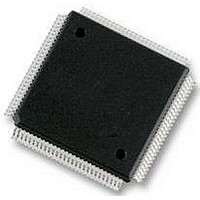XC68HC12A0CPV8 Freescale Semiconductor, XC68HC12A0CPV8 Datasheet - Page 153

XC68HC12A0CPV8
Manufacturer Part Number
XC68HC12A0CPV8
Description
IC, 16BIT MCU, 68HC12, 8MHZ, TQFP-112
Manufacturer
Freescale Semiconductor
Datasheet
1.MC912D60ACFUE8.pdf
(460 pages)
Specifications of XC68HC12A0CPV8
Controller Family/series
68HC12
No. Of I/o's
68
Eeprom Memory Size
1KB
Ram Memory Size
2KB
Cpu Speed
8MHz
No. Of Timers
1
Core Size
16 Bit
Program Memory Size
60KB
Peripherals
ADC
Lead Free Status / RoHS Status
Lead free / RoHS Compliant
- Current page: 153 of 460
- Download datasheet (5Mb)
11.6.9 Pseudo-STOP exit in Limp Home mode with Delay
11.6.10 Pseudo-STOP exit in Limp Home mode without Delay (Fast Stop Recovery)
MC68HC912D60A — Rev. 3.1
Freescale Semiconductor
CAUTION:
(NOLHM=0, CME=X, DLY=1)
When coming out of Pseudo-STOP mode with the NOLHM bit cleared
and the DLY bit set, the MCU goes into limp-home mode (regardless of
the state of the CME or FCME bits).
The VCO supplies the limp-home clock frequency to the 13-stage
counter (XCLK). The BCSP output is forced high and MCS is forced low.
After the 13-stage counter reaches a count of 4096 XCLK cycles, a
check of the clock monitor is performed and as the crystal oscillator was
kept running due to the Pseudo-stop mode, the MCU exits STOP
normally, using the EXTALi clock. In the case where a crystal failure
occurred during pseudo-stop, then the MCU exits STOP using the limp
home clock (f
home interrupt request set to indicate it is not operating at the desired
frequency. Each time the 13-stage counter reaches a count of 4096
XCLK cycles, a check of the clock monitor is performed. If the clock
monitor indicates the presence of an external clock, limp-home mode is
de-asserted, the LHOME flag is cleared and the LHIF limp-home
interrupt request is set to indicate a return to normal operation using
EXTALi clock.
(NOLHM=0, CME=X, DLY=0)
If Pseudo-STOP is exited with the NOLHM bit set to 0 and the DLY bit is
cleared then the exit from Pseudo-STOP is accomplished without delay
as in Fast STOP recovery.
Where Pseudo-STOP recovers using the Limp Home Clock the VCO -
which has been held in STOP - must be restarted in order to supply the
limp home frequency. This restart, which occurs at a high frequency and
ramps toward the limp home frequency, is almost immediately supplied
to the CPU before it may have reached the steady state frequency. It is
possible that the initial clock frequency may be high enough to cause the
CPU to function incorrectly with a resultant risk of code runaway.
VCOMIN
Clock Functions
) with both the LHOME flag set and the LHIF limp-
Limp-Home and Fast STOP Recovery modes
Clock Functions
Technical Data
153
Related parts for XC68HC12A0CPV8
Image
Part Number
Description
Manufacturer
Datasheet
Request
R
Part Number:
Description:
Manufacturer:
Freescale Semiconductor, Inc
Datasheet:
Part Number:
Description:
Manufacturer:
Freescale Semiconductor, Inc
Datasheet:
Part Number:
Description:
Manufacturer:
Freescale Semiconductor, Inc
Datasheet:
Part Number:
Description:
Manufacturer:
Freescale Semiconductor, Inc
Datasheet:
Part Number:
Description:
Manufacturer:
Freescale Semiconductor, Inc
Datasheet:
Part Number:
Description:
Manufacturer:
Freescale Semiconductor, Inc
Datasheet:
Part Number:
Description:
Manufacturer:
Freescale Semiconductor, Inc
Datasheet:
Part Number:
Description:
Manufacturer:
Freescale Semiconductor, Inc
Datasheet:
Part Number:
Description:
Manufacturer:
Freescale Semiconductor, Inc
Datasheet:
Part Number:
Description:
Manufacturer:
Freescale Semiconductor, Inc
Datasheet:
Part Number:
Description:
Manufacturer:
Freescale Semiconductor, Inc
Datasheet:
Part Number:
Description:
Manufacturer:
Freescale Semiconductor, Inc
Datasheet:
Part Number:
Description:
Manufacturer:
Freescale Semiconductor, Inc
Datasheet:
Part Number:
Description:
Manufacturer:
Freescale Semiconductor, Inc
Datasheet:
Part Number:
Description:
Manufacturer:
Freescale Semiconductor, Inc
Datasheet:










